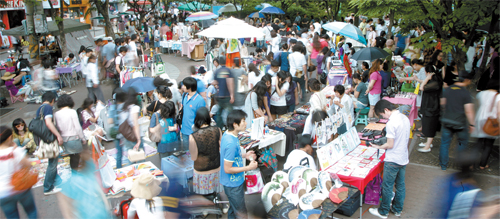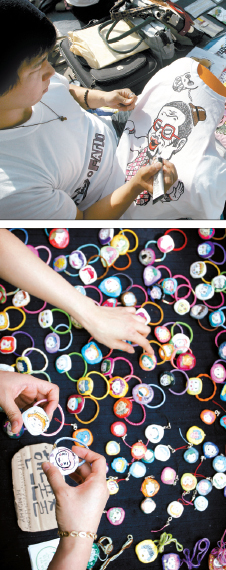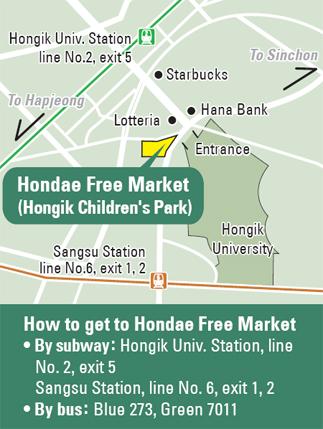Artists take their work to the streets

Saturday shoppers looking for unique handmade items crowd Hongdae Free Market in northwestern Seoul. The free market is open every Saturday from 1 to 6 p.m. near Hongik University. All photos by Oh Sang-min
Shin is among a growing number of artists making, displaying and selling their artworks at the market.
“You won’t find the jewelry sold here anywhere else,” Shin said last month while counting change for a customer who had just bought a set of handmade earrings for 15,000 won ($11.89).
When business is good, Shin says she makes more than 300,000 won a day, but that is rarely the case these days given the current state of the economy. Most days she makes less than 100,000 won. “Still, business here isn’t all about making money. It involves interacting with other artists and presenting one of a kind art items to customers.”
It’s been two years since Shin started selling her handmade artwork at a booth set up in the playground across from Hongik University. The area is transformed into a free market every Saturday from 1 to 6 p.m.
The free market was established in 2002 by the Living and Art Creative Center as part of a cultural event for the Korea-Japan World Cup of that year.
A group of people including students and professional and amateur artists founded the non-profit center to support the more isolated parts of the arts community with the creation of an arts market.
Though the market isn’t all that large right now, it is expanding, according to one of the free market organizers. There have also been free markets set up in Icheon, Bucheon and Gwangju, all in the Gyeonggi area.
Ahn Yoo-ae, who is with the center, says she hadn’t expected the free market to become as popular as it is now.
“At first, we didn’t imagine the free market would do so well in terms of sales and making an impact on the arts industry,” Ahn said, noting that the center had expected the market would last only three months before and after the World Cup.
But the following year, there was an upsurge in handmade products and the free market was in demand by both artists and consumers. So the market stayed open.
“Ever since, we have been introducing a new spending culture to consumers that allows them to stay away from buying mass-produced goods,” the organizer said.
Ahn said consumers are often encouraged to spend money on products that in the long-run harm a truly democratic market in which consumers are free from buying similar, mass-produced products.
The variety of items sold at the free market, in addition to pieces of visual art, is enormous - from handmade books to hats to knickknacks and other keepsakes - many of which are one-of-a-kind items.
Some 120 artists and crafts people sell their works at the booths that line the park, though the number of artists peddling their wares varies each week depending on the number of participants registered. Anyone can participate but the registration process is rather strict.
Participants must sell things that they have personally made by hand. All designs must be original and must not replicate those of other items in the market. When registering to participate, they need to upload three pictures of their artwork, along with a description of how it was made. Once an artist is accepted, they have to participate in a meeting held every Monday.

Top: An artist at Hongdae Free Market draws a caricature on a t-shirt to display and sell to passersby. Above: Colorful cellphone ornaments and hair bands hand made by participating artists fill a table at the market.
“It’s a street where a new trend in production and consumption is being established.”
Though she sometimes barely makes enough money to cover her transportation to and from the market, Seo says she will continue to sell her work here.
The reason is simple, and many participating artists and organizers seem to agree.
“Artworks sold at the market aren’t printed by machines,” says Lee Won-jae, director of Cultural Action and an organizing member of the Hongdae Free Market.
“The street has unique items that cannot be imitated at all.”
Kim Chan-ho, a professor of culture at Hanyang University, explains the hidden meaning behind the free market.
“‘Free market’ is an awkward term because markets should be free,” the professor said.
But the arts are different, he says. Many artists face barriers to displaying or selling their work if they don’t have the right connections.
Amateur artists, even those who are highly skilled, find it difficult to become professionals if they don’t have the support of leading artists or arts professionals.
“Sometimes it is ironic that even if there is demand for works by a certain artists, their works are not available in the market,” Kim said.
The free market is a means for some of these artists to overcome these barriers and is also a place where buyers and sellers can carry out direct transactions.
“It’s an invisible market that enhances the arts industry,” he said.
Another obstacle may be education. It’s often the case that Korean artists lack a certain amount of creativity because their education has been focused on entering college, says Carlos Manuel Navarrete, a freelance photographer and a frequent visitor to Hongdae Free Market.
“Korean art schools teach the same methods but that’s not the point of studying the arts. The arts shouldn’t be taught with the same forms but different styles should be taught,” he said, noting the free market allows artists to share ideas and creativity.
In fact, the free market is considered as a stepping stone to the professional art world. If the artists are lucky, they are selected by galleries or art centers to display or sell their works.

Though the free market is currently expanding in terms of the number of participants, there are voices of concern that in order to properly establish a bigger and more stable market, more governmental support is needed.
One of the stumbling blocks for the free market is location, according to the organizer. With the area continuing to increase in popularity, many illegal stalls and stores have opened nearby, arousing complaints from other neighborhood businesses.
The free market gets all the blame for the large crowds that gather week after week.
“We need more support in order to establish order in this area,” said Choi Hyun-jung, one of the free market organizers.
“The arts should no longer be separated from government policies or the promotion of business.”
By Lee Eun-joo [angie@joongang.co.kr]










with the Korea JoongAng Daily
To write comments, please log in to one of the accounts.
Standards Board Policy (0/250자)